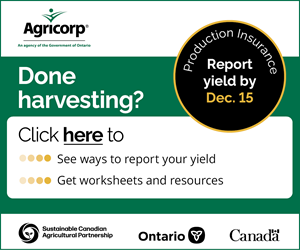Maximizing plant populations
VARIABLE RATE PLANTING TECHNOLOGY ALLOWS GREATER CONTROL IN THE FIELD
AT the wrap up of another great year there are likely many growers looking to upgrade equipment. Modern equipment has many high tech features and sometimes it seems you need the help of experienced professionals just to make sense of them all.
Sorting through the options list when ordering new equipment can be a few pages long and every “tick” in the box has a dollar figure attached to it. When taking a look at a new planter, consider one of the most discussed bells and whistles of the season: variable rate seed populations. Whether this type of option is worth ticking when sitting down to make that next iron deal requires a good understanding of how it might improve the farm’s bottom line.
specific solutions
It’s shiny, it’s new and yes, it’s expensive. But, those pricy bells and whistles may help maximize every acre with precision agronomics. Traditionally, growers often had the same management practices in all of their fields; using a few different seed varieties, one basic starter fertilizer and sometimes even one general broadcast spread.
But, the game is changing and more specific field programs are often leading to better yields and improved quality. Different fertilizers rates for this field, a different starter in that one, these two varieties here; the specificity goes on and on to coax a few more bushels out of each field. With the help of today’s equipment technology, growers have the ability to farm each acre accurately.
Plant populations have always been a discussion that can generate all kinds of responses. As technology in seed and genetics change, so does a standard answer. As we look deeper into a field we can come up with a different plant population number for different areas of the field. The list of agronomic factors that influence seed population can run quite long: soil type, rotation and disease history, among others. All those factors that can affect yield are now becoming things we can change and adjust to get the right number of plants in each acre of each field.
how it works
Modern planters have the ability to change your seed population on the go by using a pre-determined population rate that is chosen to fit with a specific soil type or Cation Exchange Capacity (CEC). Simply put, the CEC measures the soil’s ability to exchange nutrients. Ultimately every acre can be planted to its most optimal seeding rate to get that ideal plant population.
But, like most new technologies, simply buying the iron doesn’t produce results. The first step is to grid soil sample a field down to an acre or up to 2.5 acre grids. This paints a picture of two important features: the soil’s fertility requirements and the soil’s variability from grid to grid across the field. When implementing variable rate seed population, the variability of CEC is used to come up with the population ranges. Populations are adjusted based on the soil’s water holding capacity. Low water capacity equals a lower population; a higher capacity can handle a higher population. Once given this information, a planter prescription can be programmed, often with the help of a crop advisor or specialist, with a pre-determined population rate for each grid of the field.
For example, on a 100 acre field you will have approximately 40 grids; each grid is effectively a small field. Depending on the field we might see plant population range from 28,000 to 35,000 in corn. Some fields might show more variability or some might even show less. Using GPS and guidance technology, the planter knows what population needs to be planted in each GPS coordinate and automatically adjusts to the prescription.
is it worth it?
That new planter is still shiny and it’s still pricey. With such an expensive investment required, close examination of the return to the bottom line is important. With this type of technology, it’s all about dollars per acre.
One misconception is that all of this variable rate technology is about eliminating field variability by turning a farm into one consistent field. In fact, this equipment will actually demonstrate more variability in yield, or in inputs. Variable rate technology allows farmers to get the right amount of inputs in a specific area of the field. The technology’s goal is to get the highest rate of return, from each acre. When farming by prescription, a field’s poor areas become better and the best areas thrive. Don’t think of it as saving a dollar; instead consider that you’re moving that dollar to a part of the field that has a better chance of turning it into two dollars.
However, before investing in such technology, take a deep look at the farming operation and see if an upgrade in equipment technology fits within current practices and programs. Modern technology works better if there is an entire system of field specific and variable rate technology in place.
Variable rate seed population is just one tool in the growers’ tool box that makes good agronomic sense. When implemented with other precision technologies like yield mapping, variable rate fertilizer and grid specific soil sampling it becomes an even more accurate systems approach to maximizing each acre. But, this technology is probably not worth it for farmers who aren’t interested in implementing an entire system.
Maximizing every acre should be a cornerstone with any dollar spent in farming operations, but each operation maximizes those acres differently. Farmers interested in the latest site-specific technology may want to think of this technology as not just a “tick” in the box that makes new iron more expensive, but perhaps a “tick” that may help you get the most from every acre on your farm. •
About the Author:
Tony is a crop specialist with FS?PARTNERS working in Brant, Haldimand-Norfolk and Oxford counties. He is currently pursuing his Masters in Agronomy from the University of Illinois.





















